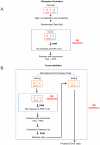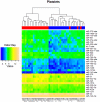Genome-wide maps of circulating miRNA biomarkers for ulcerative colitis
- PMID: 22359580
- PMCID: PMC3281076
- DOI: 10.1371/journal.pone.0031241
Genome-wide maps of circulating miRNA biomarkers for ulcerative colitis
Abstract
Inflammatory Bowel Disease--comprised of Crohn's Disease and Ulcerative Colitis (UC)--is a complex, multi-factorial inflammatory disorder of the gastrointestinal tract. In this study we have explored the utility of naturally occurring circulating miRNAs as potential blood-based biomarkers for non-invasive prediction of UC incidences. Whole genome maps of circulating miRNAs in micro-vesicles, Peripheral Blood Mononuclear Cells and platelets have been constructed from a cohort of 20 UC patients and 20 normal individuals. Through Significance Analysis of Microarrays, a signature of 31 differentially expressed platelet-derived miRNAs has been identified and biomarker performance estimated through a non-probabilistic binary linear classification using Support Vector Machines. Through this approach, classifier measurements reveal a predictive score of 92.8% accuracy, 96.2% specificity and 89.5% sensitivity in distinguishing UC patients from normal individuals. Additionally, the platelet-derived biomarker signature can be validated at 88% accuracy through qPCR assays, and a majority of the miRNAs in this panel can be demonstrated to sub-stratify into 4 highly correlated intensity based clusters. Analysis of predicted targets of these biomarkers reveal an enrichment of pathways associated with cytoskeleton assembly, transport, membrane permeability and regulation of transcription factors engaged in a variety of regulatory cascades that are consistent with a cell-mediated immune response model of intestinal inflammation. Interestingly, comparison of the miRNA biomarker panel and genetic loci implicated in IBD through genome-wide association studies identifies a physical linkage between hsa-miR-941 and a UC susceptibility loci located on Chr 20. Taken together, analysis of these expression maps outlines a promising catalog of novel platelet-derived miRNA biomarkers of clinical utility and provides insight into the potential biological function of these candidates in disease pathogenesis.
Conflict of interest statement
Figures





References
-
- Loftus EV., Jr Clinical epidemiology of inflammatory bowel disease: Incidence, prevalence, and environmental influences. Gastroenterology. 2004;126:1504–1517. - PubMed
-
- Nikolaus S, Schreiber S. Diagnostics of Inflammatory Bowel Disease. Gastroenterology. 2007;133:1670–1689. - PubMed
-
- Beniwal P, Harrell L. The status of diagnostic markers for inflammatory bowel disease. Current Gastroenterology Reports. 2010;12:479–484. - PubMed
-
- Roda G, Caponi A, Benevento M, Nanni P, Mezzanotte L, et al. New proteomic approaches for biomarker discovery in inflammatory bowel disease. Inflammatory Bowel Diseases. 2010;16:1239–1246. - PubMed
-
- Fleischhacker M, Schmidt B. Circulating nucleic acids (CNAs) and cancer-A survey. Biochimica et Biophysica Acta - Reviews on Cancer. 2007;1775:181–232. - PubMed
Publication types
MeSH terms
Substances
LinkOut - more resources
Full Text Sources
Other Literature Sources
Medical
Molecular Biology Databases

